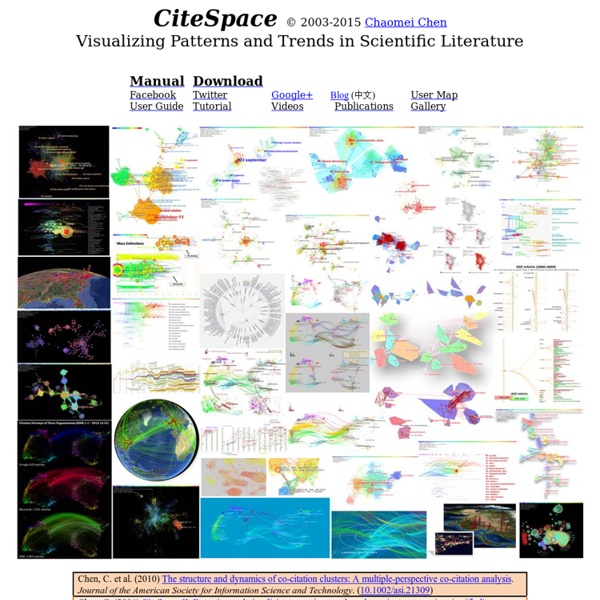CiteSpace: visualizing patterns and trends in scientific literature

AuthorMap
AuthorMap: Arts and Humanities AuthorMap explores author relationships through co-citation patterns. The assumption is that if two authors are often cited together by many other authors, these two authors likely have common intellectual interest in their research and writing. When many related authors' pair-wise co-citation patterns are explored, we will have a map of a subject domain where authors on the map represent ideas or subtopics as well as their relationships. When an author search is conducted, AuthorMap generates a list of 25 authors co-cited most often with the given author.
Digital Sociology
Between Promise and Practice: Web 2.0, Intercultural Dialogue and Digital Scholarship Professor Ien Ang Centre for Cultural Research, University of Western Sydney Dr Nayantara Pothen Centre for Cultural Research, University of Western Sydney Introduction The Internet has been a popular method for communication and collaboration across far-flung sites for some time, and its potential for enhancing participatory democracy has been much commented on. This article provides a critical (self-)analysis of diverCities: A Global Collaboration Space for Intercultural Dialogue, a digital humanities experiment. Although it was in the research team's mind to eventually launch diverCities in the public domain of the Internet, the project never reached beyond the prototype phase: this public launch will never happen because the project turned out to be inviable, and not just because of financial restrictions, as we will describe below. Intercultural Dialogue Building Content: Users and Contributors
Self-surveillance
NYU ITP graduate student Federico Zannier collected data about himself — online browsing, location, and keystrokes — for his thesis. As he dug into personal data more and looked closer at company privacy policies, he wondered what it might be like if individuals profited from their own data. That is, companies make money using the data we passively generate while we browse and use applications and visit sites. What if individuals owned that data and were able to sell it? Enter Zannier's Kickstarter campaign to sell his own data for $2 per day of activity. I started looking at the terms of service for the websites I often use. Clearly this is more of a statement and conversation starter, but what if? There's about a week left in the campaign, and it's well past the goal.
meumultiply.multiply.com/journal/item/46
Features - SocialBro
Menu SocialBro > Features Targeting How to target the right audience on Twitter Bring into clear focus your target audience of clients, customers and influencers and define the right people to engage with. Engagement How to engage with your community Use a complete suite of tools that makes it easy for you to engage with your contacts and community more efficiently. Analytics How to analyze and track your actions on Twitter Create powerful insights about your audience, their interests and interactions using powerful stats and ‘out of the box’ analysis functions to build the most effective communication strategy with the most relevant content. Management How to manage your presence on Twitter Use a complete suite of tools that makes it easy for you to engage with your contacts and community more efficiently. Company SocialBro Support Language ↑ Top
Related:
Related:



